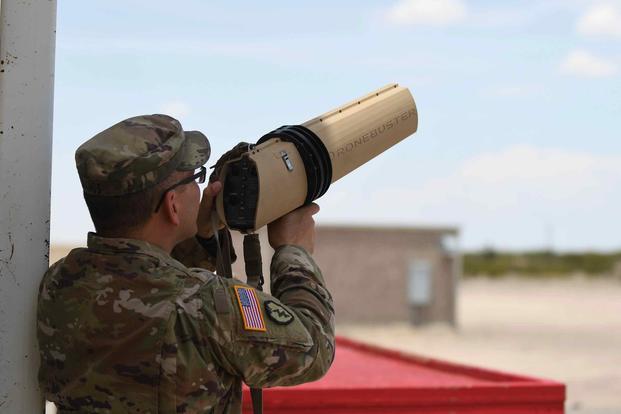The U.S. Army has come up with an initial list of the best usable counter drone technologies to destroy or deter quadcopters and other unmanned systems that pose a threat to troops and bases overseas.
The service, which was tasked with overseeing the Joint Counter-Small Unmanned Aircraft Systems Office in November, has authorized seven defensive countermeasures out 40 systems "needed to primarily detect, access, and engage with enemy drones," it said in a release.
Read Next: Major Space Force Units to Be Called Deltas, Officials Announce
In January, Under Secretary of Defense for Acquisition and Sustainment Ellen Lord announced that the Defense Department had established an office focused on addressing the growing challenge of targeting often-lethal adversary drones. The goal of the 60-person counter-drone team, led by Army Maj. Gen. Sean A. Gainey, was to determine the best systems for the task.
The Army also identified a single streamlined command and control, or C2, system that will work as the standard for its counter drone operations, Gainey said.
"This will allow the plug-and-play of emerging technology from industry into our architecture," he said in the release.
That way, the tech -- from zappers to radio jammers -- will integrate the department's networks from the start and not be limited by incompatible parts, Gainey said.
That doesn't mean the many anti-drone devices and systems the Pentagon currently uses are headed to the junkyard. The Army said those will stay in use until they can be replaced with one of the systems on the approved list.
A timeline on when they will be phased out was not provided.
The systems fall into three categories: fixed and semi-fixed systems, mobile mounted systems and handheld dismounted systems, the Army said.
"Each service has each been assigned to sponsor one of those systems," Gainey said. "So as we move this forward as a joint approach, we'll coordinate the future upgrades of these systems and the contracting of these systems across the Joint Force."
One approved structure within the fixed/semi-fixed category includes the Army's Fixed Site-Low, Slow, Small Unmanned Aircraft System Integrated Defeat System, known as FS-LIDS.
The Navy, meanwhile has chosen to use the CORIAN, or the Counter-Remote Control Model Aircraft Integrated Air Defense Network; the Air Force will use the NINJA system, or Negation of Improvised Non-state Joint Aerial-threats.
The three, which are interoperable, work to disrupt the radiofrequency signals between the UAV and its user.
The Army said that the unanimous pick for a mobile mounted anti-drone system was the Marine Corps-sponsored LMADIS, or Light-Mobile Air Defense Integrated System, which is a portable jammer. LMADIS has already seen action on deployment, taking down an Iranian drone in July 2019.
For the handheld system, the team chose to sponsor Bal Chatri, a Special Operations Command-sponsored counterweapon. However, the Drone Buster and Smart Shooter handheld systems can also be used in the field, the Army said.
Officials determined the most compatible C2 architecture system for the job is the Army's FAAD-C2, or the Forward Area Air Defense Command and Control. Interoperable systems include the Air Defense System Integrator, or ADSI, as well as the Air Force's Multi-Environmental Domain Unmanned Systems Application Command and Control, or MEDUSA.
"Our strategy is to continually improve the current capability we have," Gainey said.
"We will continue to work with industry to bring these systems to full maturity or replacement with follow-on enduring solutions," he said. "Future research, testing and investment decisions on capability modernization will consider not only the most up-to-date existing technologies but, more importantly, those new and emerging technologies currently in development."
-- Oriana Pawlyk can be reached at oriana.pawlyk@military.com. Follow her on Twitter at @Oriana0214.
Related: New Pentagon Team Will Develop Ways to Fight Enemy Drones













